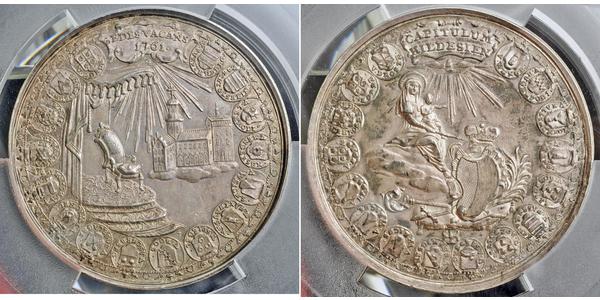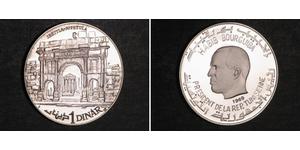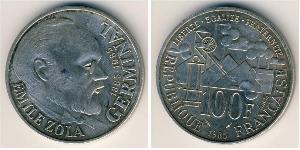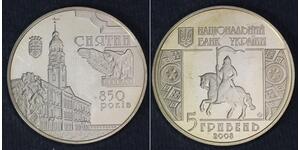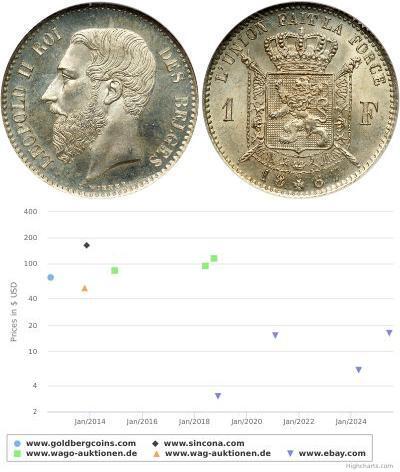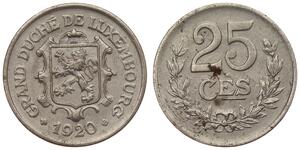(sold for $821.0)
1761, Hildesheim (Prince-Bishopric). Silver "Sede Vacante" 1½ Thaler Medal. PCGS AU-58!
Mint Year: 1761 Engraver: J. Thiebaud Denomination: 1½ Thaler Medal Mint place: Hildesheim (Prince-Bihopric) Reference: Davenport -, Mehl 676, Zepernick 145. Condition: Certified and graded by PCGS as AU-58! Weight: 43.45gm Diameter: 56mm Material: Silver
Obverse: Cathedra (bishop's chair) facing slightly right under canopy and set upon three-tiered dais. Inscribed cartouche above illuminated all-seeing Eye of Providence above shining upon Cathedral in background to right. All within border of 16 crowned coats-of-arms. Legend: SEDES VACANS / 1761 .
Reverse: The Virgin (Madonna) seated in clouds, holding baby-Jesus child and pointing to crowned coat-of-arms on a pillow with Prince-Bishop´s regalia with scepter. Cartouche and illuminated Holy Spirit above. All within border of 16 crowned coat-of-arms. Legend: CAPITULUM HILDESIEN
The Diocese of Hildesheim (Latin:Dioecesis Hildesiensis) is a diocese or ecclesiastical territory of the Latin Rite of the Catholic Church in Germany. Founded in 815 as a missionary diocese by King Louis the Pious, his son Louis the German appointed the famous former archbishop of Rheims, Ebbo, as bishop. The Diocese of Hildesheim continues to exist; today, it covers those parts of the State of Lower Saxony that are east of the River Weser, northern neighbourhoods in Bremen, and the city of Bremerhaven. The current bishop is Norbert Trelle who was appointed in 2006. The diocese is a suffragan to the Archdiocese of Hamburg since 1994. Originally Hildesheim was suffragan to Mainz until 1805. Then it was an exempt diocese until 1930, before it was part of the Middle German Ecclesiastical Province with Paderborn Archdiocese as metropolitan between 1930 and 1994.
Between 1235 and 1802, the bishop of Hildesheim was also Prince of the Holy Roman Empire. His Hochstift (feudal princely territory) was the Prince-Bishopric of Hildesheim. In the 16th century, most of the diocese as well as most of the state of Hildesheim switched to protestantism. But the Bishopric managed to retain its independence from the surrounding protestant states of Brunswick-Lüneburg, mostly because its bishops were members of the powerful House of Wittelsbach from 1573 until 1761.
Hildesheim is a city in Lower Saxony, Germany with 103,804 inhabitants. It is in the district of Hildesheim, about 30 km (19 mi) southeast of Hanover on the banks of the Innerste River, a small tributary of the Leine River. With the Hildesheim Cathedral and the St. Michael's Church Hildesheim has become a UNESCO World Heritage site in 1985.
Hildesheim, one of the oldest cities in Northern Germany, became the seat of the Bishopric of Hildesheim in 815 and may have been founded when the bishop moved from Elzeto the Innerste ford, which was an important market on the Hellweg trade route. The settlement around the cathedral very quickly developed into a town and was awarded market rights by King Otto III in 983. Originally the market was held in a street called Old Market (Alter Markt) which still exists today. The first market place was laid out around the church St. Andreas. When the city grew further, a bigger market place became necessary. The present market place of Hildesheim was laid out at the beginning of the 13th century when the city had about 5,000 inhabitants. When Hildesheim obtained city status in 1249, it was one of the biggest cities in Northern Germany. For four centuries the clergy ruled Hildesheim, before a city hall was built and the citizens gained some influence and independence. Construction of the present City Hall started in 1268. In 1367 Hildesheim became a member of the Hanseatic League. A war between the citizens and their bishop cost dearly in 1519–23 when they engaged in a feud. Hildesheim became Lutheran in 1542, and only the cathedral and a few other buildings remained in imperial (Catholic) hands. Several villages around the city remained Catholic as well. In 1813, after the Napoleonic Wars, the town became part of the Kingdom of Hanover, which was annexed by the Kingdom of Prussia as a province after the Austro-Prussian War in 1866. In 1868 a highly valuable trove of about 70 Roman silver vessels for eating and drinking, the so-called Hildesheim Treasure, was unearthed by Prussian soldiers.
The city was heavily damaged by air raids in 1945, especially on 22 March. Although it had little military significance, two months before the end of the war in Europe the historic city was bombed as part of the Area Bombing Directive in order to undermine the morale of the German people. 28.5% of the houses were completely destroyed and 44.7% damaged. 26.8% of the houses remained undamaged. The centre, which had retained its medieval character until then, was almost levelled. As in many cities, priority was given to rapid building of badly needed housing, and concrete structures took the place of the destroyed buildings. Most of the major churches, two of them now UNESCO World Heritage Sites, were rebuilt in the original style soon after the war. During the war, valuable world heritage materials had been hidden in the basement of the city wall. In 1978, the University of Hildesheim was founded. In the 1980s a reconstruction of the historic centre began. Some of the unattractive concrete buildings around the market place were torn down and replaced by replicas of the original buildings. In the autumn of 2007, a decision was made to reconstruct the Umgestülpter Zuckerhut ("Upended Sugarloaf"), an iconic half-timbered house famous for its unusual shape. In 2015 the city celebrates it's 1200 anniversary with the Day of Lower Saxony.

|
Posted by:
anonymous 2018-12-18 |
One of them is

